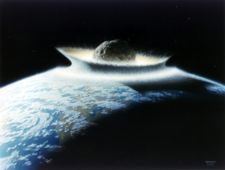Many bodies have struck Earth and the Moon in the past, and one widely accepted theory blames the impact 65 million years ago of an asteroid or comet at least 6 miles (10 kilometers) in diameter for mass extinctions among many lifeforms, including the dinosaurs. Other theories suggest that the chemical building blocks of life and much of Earth’s water arrived on asteroids or comets that bombarded the planet in its youth.
 On June 30, 1908, a small asteroid 330 feet (100 meters) in diameter exploded over the remote region of Tunguska in Siberia, devastating more than half a million acres of forest. One of the most recent close calls occurred on March 23, 1989, when an asteroid 0.25-mile (0.4- kilometer) wide came within 400,000 miles (640,000 kilometers) of Earth. Surprised scientists estimated that Earth and the asteroid — weighing 50 million tons and traveling at 46,000 miles/hour (74,000 kilometers/hour) — had passed the same point in space just six hours apart.
On June 30, 1908, a small asteroid 330 feet (100 meters) in diameter exploded over the remote region of Tunguska in Siberia, devastating more than half a million acres of forest. One of the most recent close calls occurred on March 23, 1989, when an asteroid 0.25-mile (0.4- kilometer) wide came within 400,000 miles (640,000 kilometers) of Earth. Surprised scientists estimated that Earth and the asteroid — weighing 50 million tons and traveling at 46,000 miles/hour (74,000 kilometers/hour) — had passed the same point in space just six hours apart.
Since the Earth was formed more than four billion years ago, asteroids and comets have routinely slammed into the planet. The most dangerous asteroids are extremely rare, according to NASA.
An asteroid capable of global disaster would have to be more than a quarter-mile wide. Researchers have estimated that such an impact would raise enough dust into the atmosphere to effectively create a “nuclear winter,” severely disrupting agriculture around the world. Asteroids that large strike Earth only once every 1,000 centuries on average, NASA officials say.
Smaller asteroids that are believed to strike Earth every 1,000 to 10,000 years could destroy a city or cause devastating tsunamis.